
Words by Teresa Mungazi, Newcastle University
According to the Food and Agriculture Organisation (FAO), adopting sustainable diets on a global level is urgently needed.
However, there is an ongoing debate on the risks and benefits of consumption of certain foods and what a sustainable diet represents. As such some of the results are mixed. This obviously leaves the consumer confused about what to eat – a survey by “Beef Daily” revealed that there are many misconceptions about food by the consumers and they do not know where to turn to for answers.
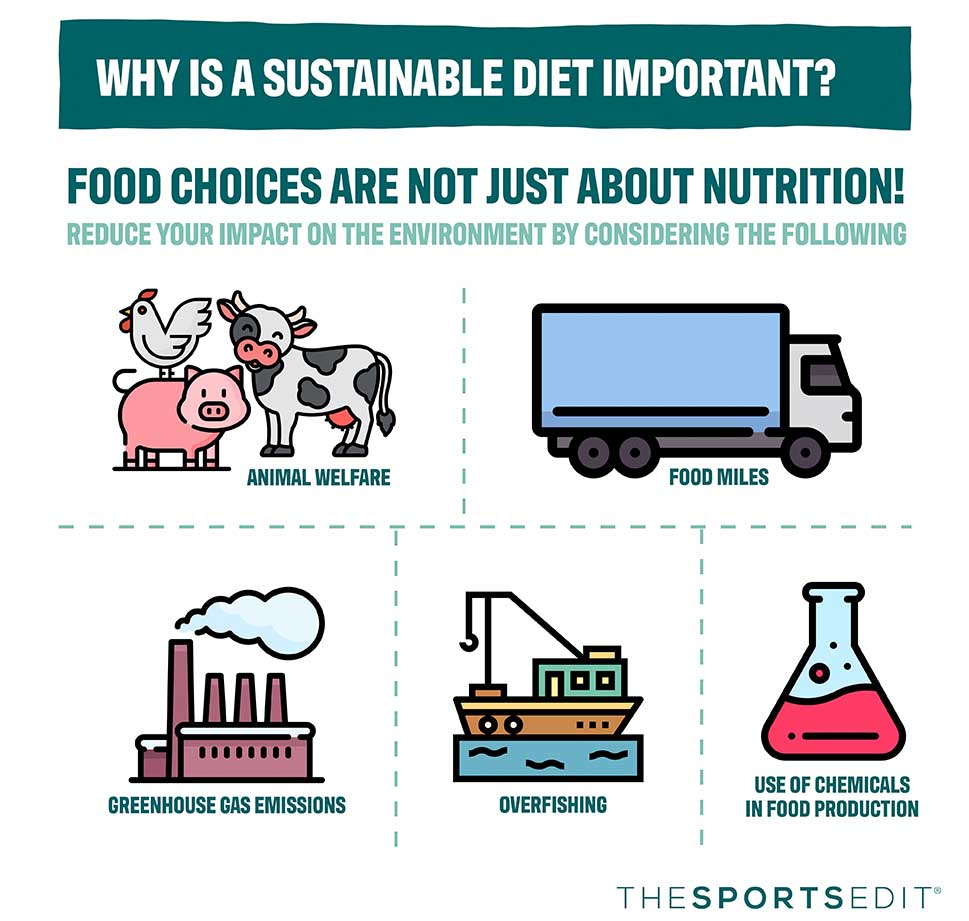
With the growing need to reduce our impact on the environment, healthy and sustainable diets have become an important component of sustainable living. And it’s easy to see how a lot more considerations besides nutrition would need to be made when choosing to follow a more sustainable diet.
How can we interpret the term ‘sustainable diet’?
The Food and Agriculture Organisation (FAO) defines sustainable diets as, “nutritionally adequate, safe, healthy, culturally acceptable, economically affordable diets that have little impact on the environment”.
Life Cycle Assessments (LCA) have been central in understanding supply chain efficiencies of food products. Meat production has been found to generally have higher environmental impacts compared to the other food types reviewed in this report. Although still fragmented, there is increasing consensus that transitioning towards reduced meat consumption and more plant-based diets is important for addressing current health and sustainability challenges.
How can we each make a difference?
Sustainable choices made by individuals can encourage more sustainable production systems due to the “supply and demand effect”. For this reason, it is important for the consumer to understand what healthy and sustainable consumption involves and what choices they have.
It is not easy to establish what a sustainable diet within a given context would entail, because there are so many factors involved and understanding what constitutes a sustainable diet depends on populations and contexts.
But the good news is that in general, foods with a lower relative environmental impact, are often also associated with reduction in mortality risk. So eating healthily and eating sustainably sit side by side. The same changes in diet that help reduce the risk of noncommunicable diseases should also help with an individual’s and society’s sustainability goals.

Source: Tilman, Clark, Springmann, Hill; PNAS, September 2019
To get a greater insight of the sustainable implications of food, let’s look at the specifics of different food types.

MEAT
There is more use of industrially produced meat than ever before. It is acknowledged that meat is sometimes a good source of nutrients, but both qualitatively and quantitatively the meat production of today has become unsustainable, especially compared to how it was acquired in the past (de Boer and Aiking, 2017).
Health and environmental risks of eating meat
Numerous studies have indicated that eating red or processed meat is not good for health – it is associated with increased risk for heart disease, cancer and early death. The World Health Organisation (WHO) even lists red meat as a probable carcinogen and processed meat as a carcinogen.
Meat consumption has been suggested to be one of the primary factors in diet-related greenhouse gas emissions. Beef in particular represents around 65% of the livestock sector’s emissions, due to the methane produced by belching plus the large scale land use required for such farming (Food & Agriculture Organisation of the United Nations).
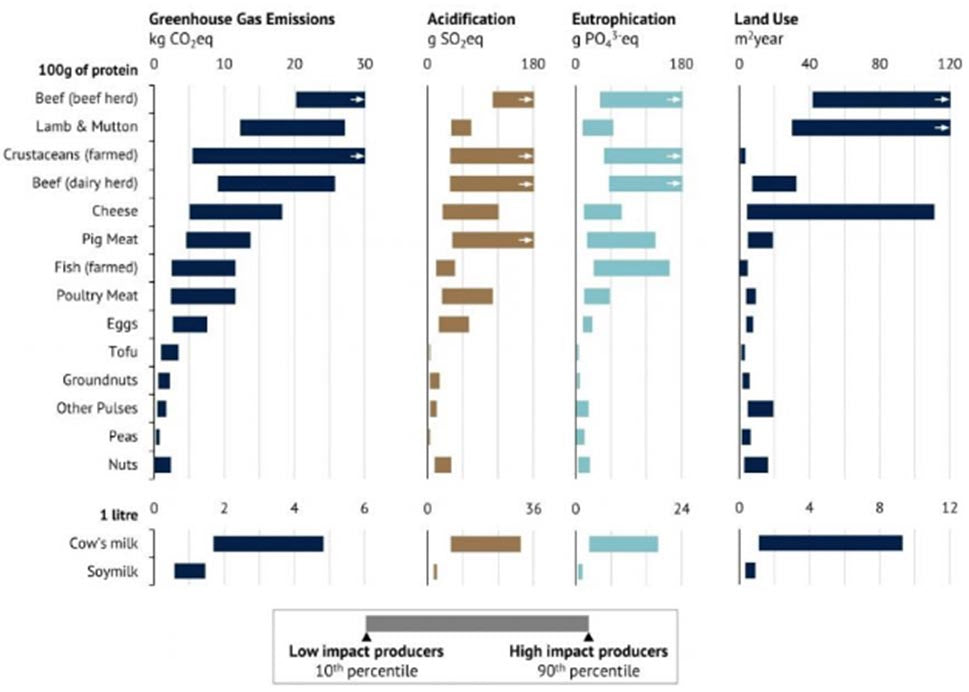
Meat (especially red meat) however, provides a rich source of high biological value protein and essential nutrients, some of which are more bioavailable than in alternative food sources (Wyness, 2016). Given the importance of nutritional adequacy, and the risk/benefit debate amongst health experts, it is important for the consumer to understand what healthy and sustainable meat consumption involves.
Should I eat meat at all?
The question the consumer often asks is, “what is the right amount of red or processed meat to eat?”
Increasingly, the answer for both the planet and the individual is, “very little”. According to contemporary guidelines, consumption of unprocessed red meat and processed meat should be limited.
For example; the 2015–2020 Dietary Guidelines for Americans recommend limiting red meat intake, including processed meat, to approximately 1 weekly serving. United Kingdom dietary guidelines endorse limiting the intake of both red and processed meat to 709 g/d.
However these recommendations have been suggested to be primarily based on observational studies which only examine association between eating meat and specific diseases. But, when studies find an association between two things, it doesn’t mean that one thing causes the other to happen - association does not mean causation (because humans are exposed to many other things that may cause the same diseases). There is no solid evidence of cause and effect but only evidence of some relationship between meat eating and some specific diseases (Johnston et al., 2019).
Other scientific authors like Sabaté and Soret (2014) argue that “from a strict health perspective, there is no need to consume meat,” but more evidence is required to substantiate the argument.
The benefits of reducing meat consumption
Reducing meat intake has the ability to balance the need for whatever we like to eat and the need to take care of the Earth that we rely on for sustenance.
Whether or not the modern human is capable of getting to that place is another question. Currently, it is important to generate higher-quality evidence regarding the magnitude of any causal effect of meat consumption on health outcomes.
So how can I make my meat consumption more sustainable?
On the consumer level, especially for consumers in developed countries, it is key to avoid overconsumption of meat. If you are looking to consume meat in a more sustainable way, a good starting point is to:
- Choose smaller scale meat producers who provide good animal welfare and a natural diet for livestock (that is locally sourced)
- Minimise consumption of processed meat
- Approach meats differently according to their environmental impact. For example, beef and lamb can be seen as a special treat, while chicken as a more sustainable meat choice can be eaten more regularly
- Incorporate more plant-based foods into your diet
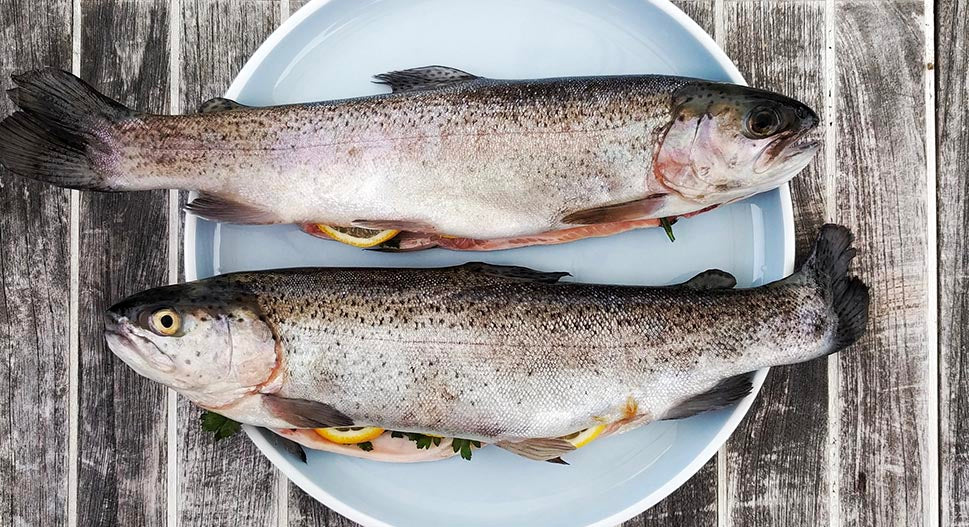
FISH
The growing concerns about meat overconsumption in developed countries has led to the promotion of fish and shellfish as healthy alternatives to other animal protein (Thurstan and Roberts, 2014).
Research suggests that a diet rich in fish protein has the following health benefits:
- Lower risk of cardiovascular disease
- Critical for neurological development and health, thanks to its Omega 3 fatty acids
- High in dietary nutrients such as calcium, selenium and zinc
Various national and international bodies have recommended how much fish we should eat to benefit health, with examples from 97 to 550 g capita−1 week−1 (Table 1).
The environmental risks of eating fish
Despite the health benefits of consuming fish and its promotion as an alternative to overconsuming other meats, there is in fact a crisis in the global fish supply (Watson et al., 2014).
The important question to ask is whether there are actually enough fish to go around to meet health aspirations, both now and into the future – especially since overfishing is the greatest single threat to marine life.
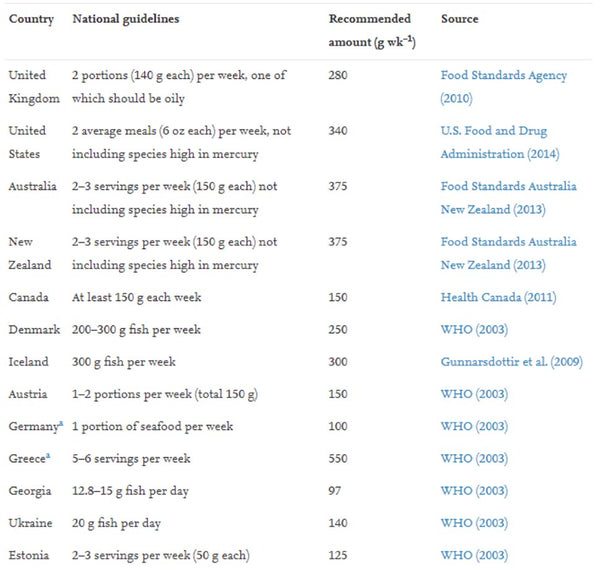
Table 1: National guidelines for recommended fish consumption
So how can I make my fish consumption more sustainable?
The consumer is now becoming more aware of the implications of seafood choices through education campaigns and guidelines designed to prevent overfishing, reduce by-catch of non-targeted endangered species, and protect marine habitat.
One example is the Marine Conservation Society’s “Good Fish Guide”, which is regularly updated. The Marine Conservation Society urges consumers, especially Britons to try more unusual fish options besides the favoured cod, salmon, tuna, prawns and haddock, to encourage demand for more sustainable options.
At the moment, the blue tick logo on label is the best way to identify fish with a sustainable status. The blue tick is awarded by the Marine Stewardship Council (MSC) based on an examination of stocks, the fishing practices employed and the traceability of the wild fish.
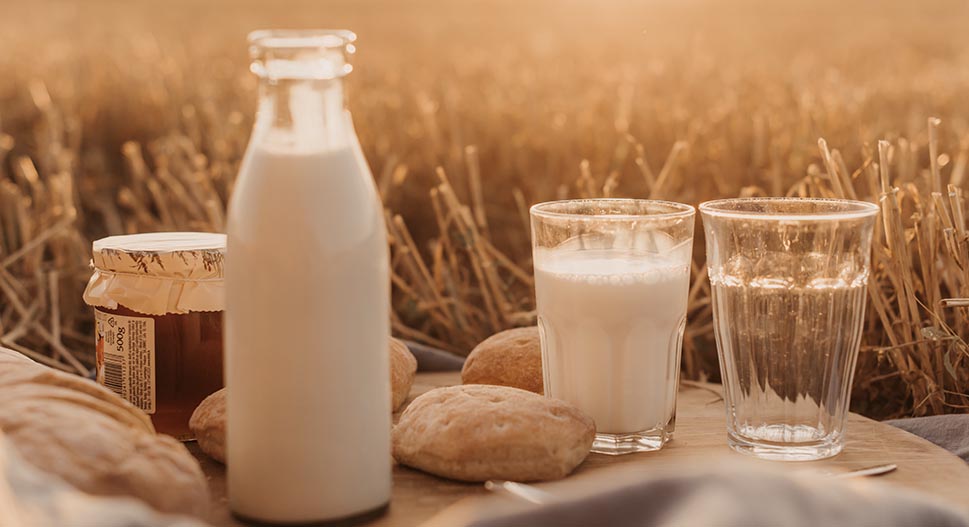
DAIRY
According to the Food and Agriculture Organisation, milk and dairy products can be important in diversifying the diet and provide high quality protein and micronutrients. They can be considered important sources of the following key nutrients:
- Calcium
- Magnesium
- Selenium
- Riboflavin
- Vitamin B12
- Pantothenic acid
Dairy products are also considered to be an affordable source of nutrition to meet daily nutrient requirements (Miller and Auestad, 2013).
The health and environmental risks of eating dairy
There may be health benefits, however the dairy industry is known to produce large volumes of wastewater (up to 10 L L−1 raw material), with treatment costs as high as 3374 US$ per cubic metre of effluent treated.
The biological oxygen demand reaches 48 g L−1, while the chemical oxygen demand reaches 95 g L−1 (Yifei et al., 2019).
The main source of dairy wastewater was shown to be milk powder (due to water evaporation and condensation) followed by butter, cheese and UHT milk (Wallace and Johnstone, 2010).
Secondly, like with beef farming, dairy farming of cows also has a heavy carbon impact on the environment due to high levels of methane produced by the cows, along with the extensive land use required to farm the cattle.
Thirdly, it’s important to note that most of the dairy products we find in the grocery store are made from conventional milk, which can cause harm to health because of antibiotics, hormones and steroids used on the cows mass-producing the milk. This emphasises the need to consider how the milk-giving animals were raised and how the dairy was processed in order to attain the best quality and health benefits.
Should I switch to plant milk?
In the UK, the dramatic rise in veganism has resulted in increased consumption of dairy alternatives such as almond and soy milk. There is however conflict in science over the health and environmental impacts of milk vs its alternatives and this can be a headache for consumers trying to live sustainably.
Even though there is a need for more studies to establish which is better for the environment, overall the production of most plant-based dairy alternatives has been suggested to be better for the environment compared to cow’s milk.
So how can I make my dairy consumption more sustainable?
If cow’s milk products are to be consumed, milk from sustainably farmed animals would be the best choice. In the UK, signs to look out for include:
- Free Range Dairy Network Pasture Promise Pasture for Life
- Organic Milk certification by the Soil Association
- RSPCA Assured
- Good Dairy Awards

EGGS
Eggs are an important source of animal protein and have much less of an environmental impact than meat production. The high protein content of eggs has made them an important part of the human diet both as shell eggs and as an ingredient in numerous food sources for centuries. Eggs contain all of the proteins, lipids, and a substantial amount of vitamins, and minerals (Kovacs-Nolan et al., 2005). The egg white contains high-quality protein, riboflavin and selenium and the yolk is packed with vitamins and minerals including;
- Vitamin D
- Vitamin A
- Vitamin B12
- Vitamin B5
- Vitamin B2
- Phosphorus
- Folate
- Choline
- Lutein
- Zeaxanthin
- Antioxidants
The health and environmental risks of eating eggs
There is a perception that egg yolks contain dietary cholesterol, and this has either limited egg consumption or selective preference of egg whites, leading to “missing out” on beneficial components of the yolk (Fernandez and Andersen, 2016).
Some studies have shown that cholesterol in diet doesn't necessarily cause high cholesterol in blood (Fernandez, 2012). But recently, a study published in the Journal of American Medical Association concluded that the recommended 3 to 4 eggs per week may increase risk of heart failure, coronary heart disease and stroke. However drawing definitive conclusions based on a single study is difficult. It is therefore advisable for consumers to adopt a consumption pattern most suited to their cardiovascular health (in consultation with a health care expert).
On the environmental side, some of the egg production systems have raised concerns amongst the consumer. Currently, conventional cages are the most common housing systems, but they have been considered to be unsustainable and have been frowned upon by the consumer (Ochs et al., 2019) – because of environmental and animal welfare concerns.
So how can I make my consumption of eggs more sustainable?
The egg industry is now moving towards “cage-free” aviary systems as alternatives to the conventional cage systems. There is ongoing research on improving the welfare of laying hens, and there are various certifying bodies for animal welfare including; Certified Humane Raised and Handled®, and United Egg Producers (UEP). Certified humane gives clear guidelines to assist consumers to decipher the varying labels that are found on eggs, to understand the level of adherence to animal welfare standards.
However, a lot of eggs consumed come in other forms e.g. in mayonnaise, salad dressings, frozen foods, restaurant meals, and other contexts where it's hard to judge where the eggs came from and what conditions the hens were raised in. In this case, it may be wise to reduce your consumption of eggs.
With Regards to health and safety, the British Lion eggs are considered to be the safest and are said to be the only eggs that are safe to be consumed runny (even raw) by vulnerable groups. These eggs are easily identified by the lion symbol but it is important to note that the symbol does not necessarily mean that the eggs are organic or free range.

PLANT-BASED
Plant-based diets are associated with a lot of health benefits and there is a growing consensus that increased consumption of plant-based foods along with reduced consumption of meat and other animal-based products will improve sustainability of food systems.
Plant products have higher energy efficiency when considering the ratio of outputs/inputs per calorie (Eshel and Martin, 2006).
Plant-based diets, especially when rich in high quality plant foods such as whole grains, fruits, vegetables, and nuts are also associated with lower risk of cardiovascular outcomes.
According to (Poore and Nemecek, 2018) more than half of all diet-related deaths are attributed to low intake of whole grains and fruit. Some scientific authors have suggested that an important feature for transformation of diets in Western industrialised countries is a shift away from animal sourced foods, towards plant-based meals (Graça et al., 2019b).
The health and environmental risks of a plant-based diet
As some scholars have argued, eating lamb chops from a farm a few miles down the road is sustainably better than eating avocados from another side of the world. It’s important for consumers to bear in mind that it is not only about transitioning to an increasingly plant-based diet, but taking food miles and other factors into consideration.
Other areas of concern would be deprivation of local markets as the food makes its way to more developed countries, especially with the prevailing “superfood” hype, which has led to limited access of these foods by local communities.
So how can I make my plant-based diet more sustainable?
Transitioning to an increasingly plant-based diet is a process that requires a positive and open mindset. The journey is part of the fun and it can be attained in stages.
Consuming a broader variety of locally-sourced food is of paramount importance if the transition to plant-based diets is going to reap any sustainable results at all.
Further, making a conscious choice to eat seasonally is not only healthy and keeps you in tune with the cycles of nature, but will reduce production costs both financially and environmentally in the producing countries (Macdiarmid, 2014).
Buying from local farmers markets and creating your own easy sustainable gardens will also help contribute to sustainable plant-based diets.
SUSTAINABLE FOOD LABELS
The increasing demand for sustainable food products has driven manufacturers to adopt many sustainability claims, certifications, messages and other information tools to differentiate their goods.
Environmental and ethical labels can be confusing as it may be difficult to decipher to what extent certain production standards are adhered to under each label. The most popular labels are as follows:

It is a legal requirement in the EU to include the Country of Origin label (COO) too, to guide the consumer.
Currently, labels are not clear enough to show the method of production, but there are on-going campaigns for clearer (and more honest) labelling. Further, there are available resources online that give more detailed production information in order to guide the consumer’s decision making with regards to eating sustainably produced food.
'Compassion in World Farming' (CIWF) is a great place to find out information on sustainable producers, methods of production and a list of animal welfare award winners.
CONCLUSION
It is safe to conclude that if you are interested in healthy and sustainable diets, it’s more about eating core foods than avoiding specific food groups.
Locality and regional geography are an essential component of the sustainability equation.
Most food industries are restructuring to become more sustainable, especially in the UK.
You the consumer can contribute to the rural economies by supporting local agriculture.
In a nutshell, consuming higher welfare products and less meat is a more sustainable approach to consumption that is better for the people, the animals and the planet.
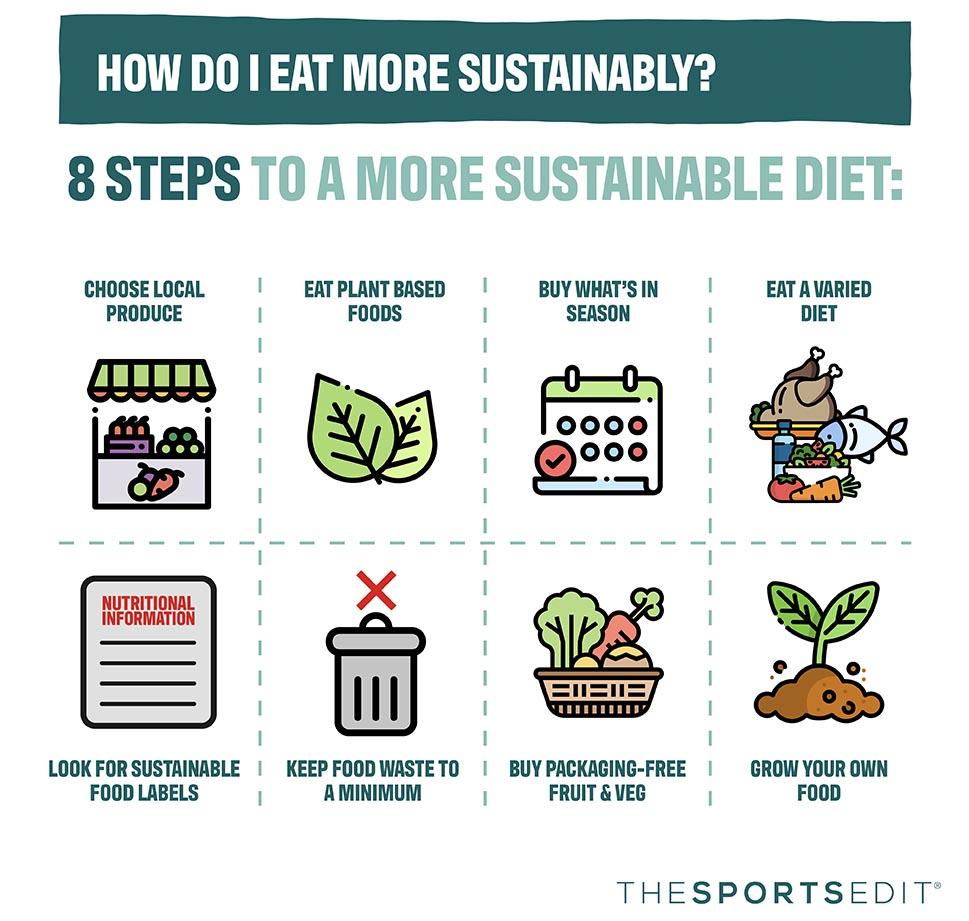
References
de Boer, J. and Aiking, H. (2017) 'Pursuing a Low Meat Diet to Improve Both Health and Sustainability: How Can We Use the Frames that Shape Our Meals?', Ecological Economics, 142, pp. 238-248.
Eshel, G. and Martin, P.A. (2006) 'Diet, energy, and global warming', Earth interactions, 10(9), pp. 1-17.
Fernandez, M.L. (2012) 'Rethinking dietary cholesterol', Current Opinion in Clinical Nutrition & Metabolic Care, 15(2), pp. 117-121.
Fernandez, M.L. and Andersen, C.J. (2016) 'Eggs: Composition and Health Effects', in Caballero, B., Finglas, P.M. and Toldrá, F. (eds.) Encyclopedia of Food and Health. Oxford: Academic Press, pp. 470-475.
Graça, J., Godinho, C.A. and Truninger, M. (2019a) 'Reducing meat consumption and following plant-based diets: Current evidence and future directions to inform integrated transitions', Trends in Food Science & Technology, 91, pp. 380-390.
Graça, J., Truninger, M., Junqueira, L. and Schmidt, L. (2019b) 'Consumption orientations may support (or hinder) transitions to more plant-based diets', Appetite, 140, pp. 19-26.
Johnston, B.C., Zeraatkar, D., Han, M.A., Vernooij, R.W.M., Valli, C., El Dib, R., Marshall, C., Stover, P.J., Fairweather-Taitt, S., Wójcik, G., Bhatia, F., de Souza, R., Brotons, C., Meerpohl, J.J., Patel, C.J., Djulbegovic, B., Alonso-Coello, P., Bala, M.M. and Guyatt, G.H. (2019) 'Unprocessed Red Meat and Processed Meat Consumption: Dietary Guideline Recommendations From the Nutritional Recommendations (NutriRECS) Consortium', Annals of Internal Medicine.
Kovacs-Nolan, J., Phillips, M. and Mine, Y. (2005) 'Advances in the Value of Eggs and Egg Components for Human Health', Journal of Agricultural and Food Chemistry, 53(22), pp. 8421-8431.
Lacour, C., Seconda, L., Allès, B., Hercberg, S., Langevin, B., Pointereau, P., Lairon, D., Baudry, J. and Kesse-Guyot, E. (2018) 'Environmental Impacts of Plant-Based Diets: How Does Organic Food Consumption Contribute to Environmental Sustainability?', Frontiers in Nutrition, 5(8).
Macdiarmid, J.I. (2014) 'Seasonality and dietary requirements: will eating seasonal food contribute to health and environmental sustainability?', Proceedings of the Nutrition Society, 73(3), pp. 368-375.
Ochs, D., Wolf, C.A., Widmar, N.O., Bir, C. and Lai, J. (2019) 'Hen housing system information effects on U.S. egg demand', Food Policy, 87, p. 101743.
Perignon, M., Vieux, F., Soler, L.-G., Masset, G. and Darmon, N. (2016) 'Improving diet sustainability through evolution of food choices: review of epidemiological studies on the environmental impact of diets', Nutrition Reviews, 75(1), pp. 2-17.
Poore, J. and Nemecek, T. (2018) 'Reducing food’s environmental impacts through producers and consumers', Science, 360(6392), pp. 987-992.
Thurstan, R.H. and Roberts, C.M. (2014) 'The past and future of fish consumption: Can supplies meet healthy eating recommendations?', Marine Pollution Bulletin, 89(1), pp. 5-11.
Watson, R., Zeller, D. and Pauly, D. (2014) 'Primary productivity demands of global fishing fleets', Fish and Fisheries, 15(2), pp. 231-241.
Wyness, L. (2016) 'The role of red meat in the diet: nutrition and health benefits', Proceedings of the Nutrition Society, 75(3), pp. 227-232.
































































